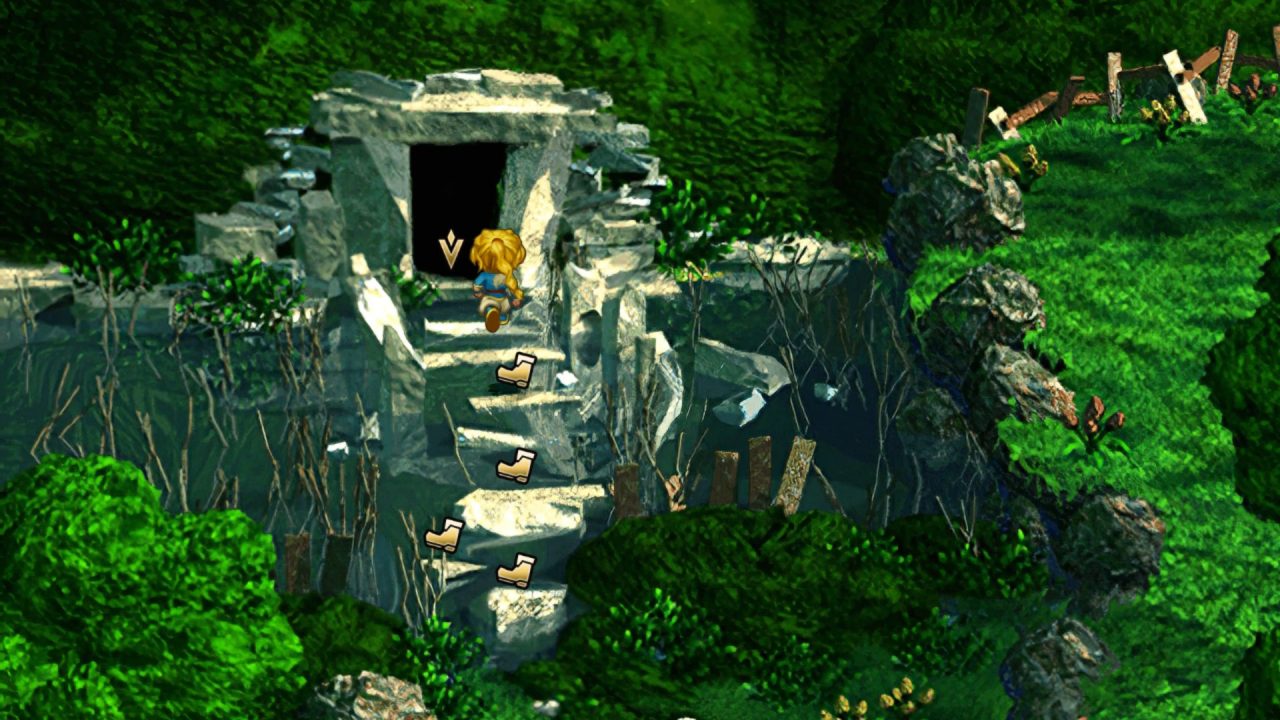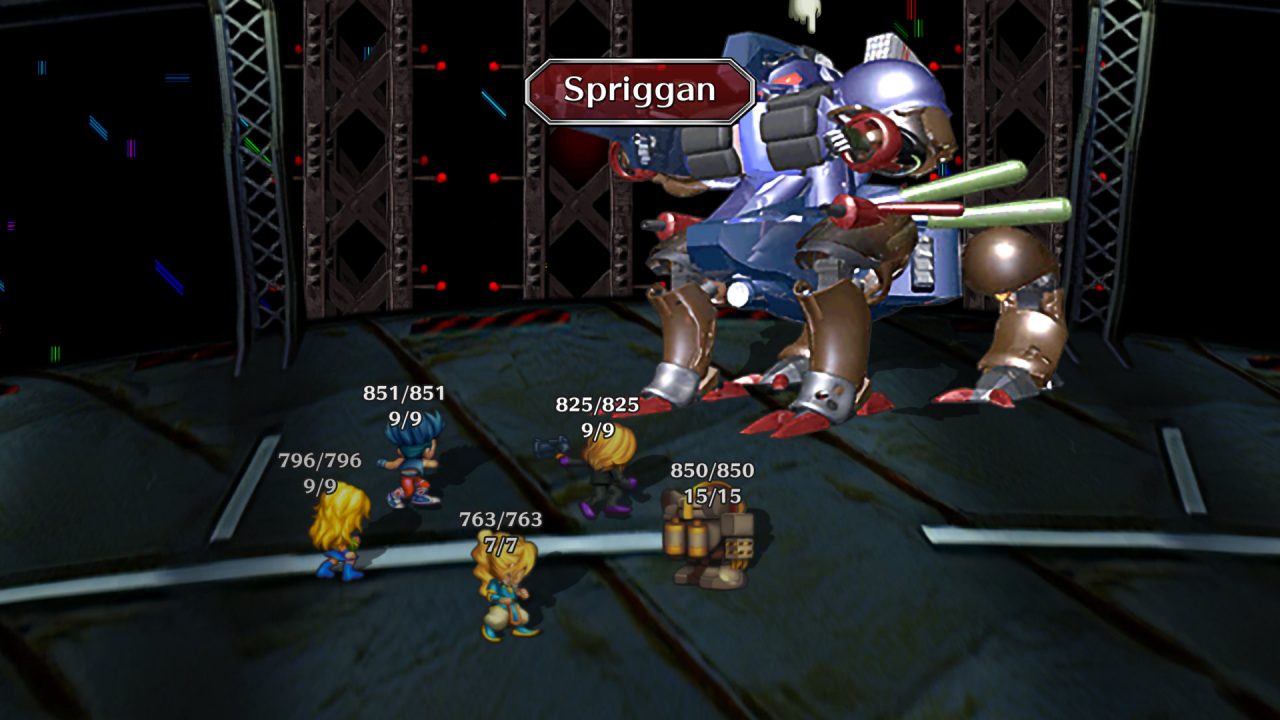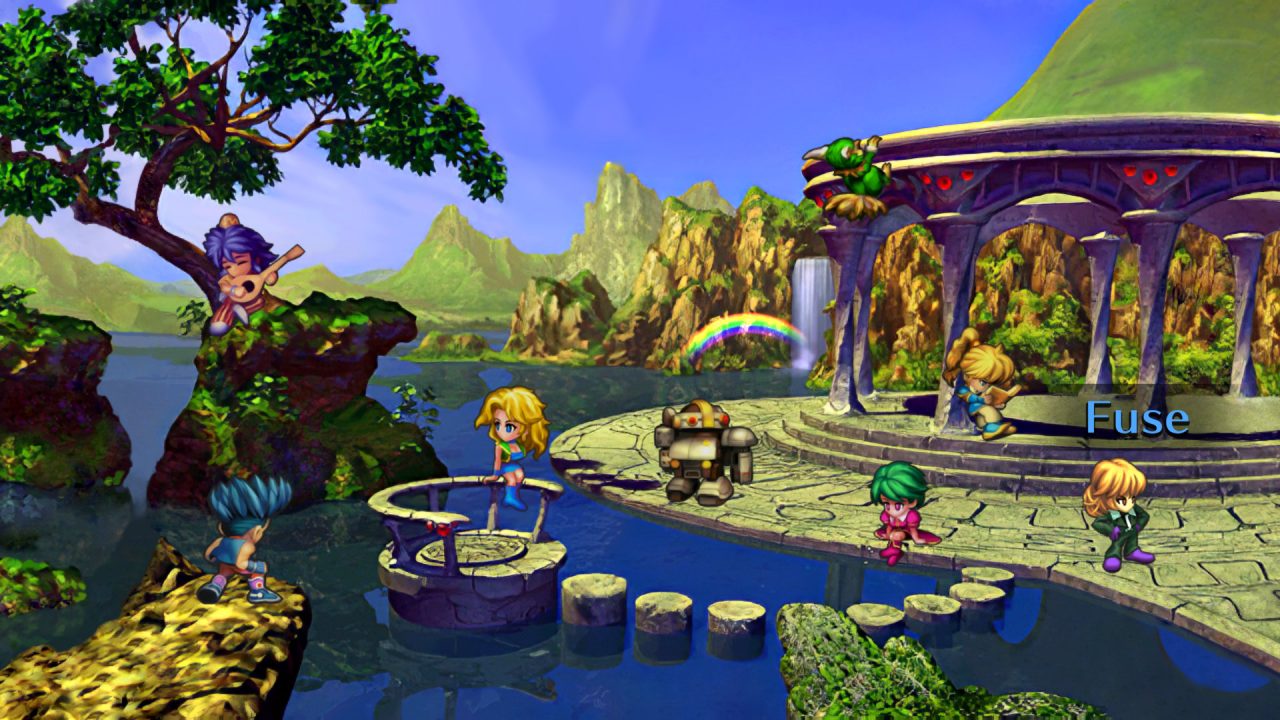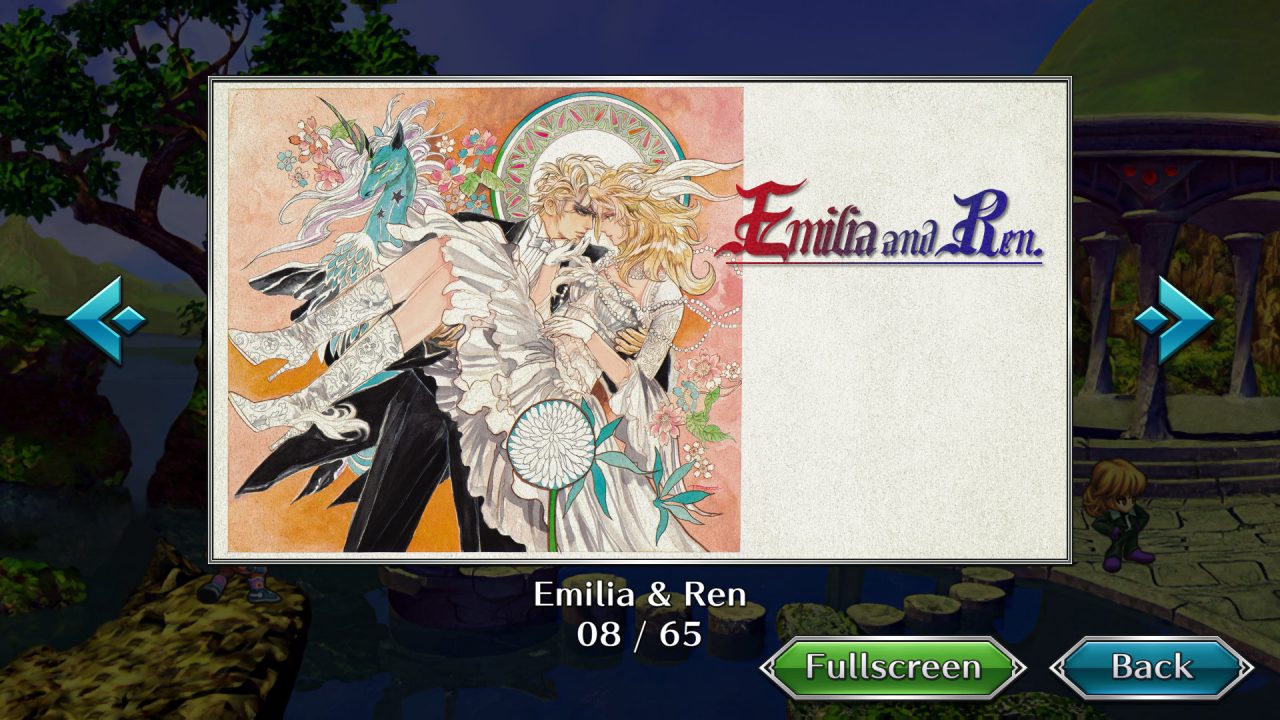The SaGa franchise is one near and dear to my heart. And, as the bevy of ports, remasters, and arranged music from Square Enix suggests, I’m not alone in this sentiment. Despite having a sort of “black sheep” status in JRPG fandom for its obtuse mechanics and sometimes punishing difficulty, each SaGa title still warrants consideration on its own merits, much like the Final Fantasy series.
One of the most controversial entries in the series is the one that made the jump from 16-bit (Super Famicom) to 32-bit (Sony PlayStation): SaGa Frontier. Akitoshi Kawazu‘s most ambitious title to date, it was sadly rushed out the door in Japan to make way for larger, big-budget projects at the time from Square. When localized for English-speaking audiences a short time later, nothing from the original Japanese version’s “rush” was fixed. This meant rushed scripts, missing scenes causing confusion in characters’ stories, and a handful of bugs were all part of the English language experience. Worse yet, the translation left a lot to be desired. As someone who played through all seven characters’ scenarios in my childhood, I can remember clearing an entire character’s story and walk away thinking, “What just happened here?”
Over two decades later, Square Enix made the bold move to publish a full HD Remaster of SaGa Frontier for Switch, PS4, and PC (Steam). This release follows on the recent ports of Romancing SaGa 2, Romancing SaGa 3, and the SaGa 1,2,3 (Final Fantasy Legend) Collection on Switch. This particular remaster went further than any of the previous re-releases, however. The improvements make a game that was once considered “controversial” (in that gamers either loved or loathed it) into something palatable — if you don’t love it, at least you can withstand and appreciate it.
I Feel Pretty…
The most noticeable improvement from the moment I booted up the game? The graphics. No, there wasn’t any significant change or rework. This isn’t Final Fantasy VII Remake. But, it just so happens that I had the original PSOne Classics version of SaGa Frontier to compare and contrast, to see how the Remaster did on upscaling the pre-rendered backgrounds and detailed sprites. In short, the change is marvelous. The tedious, technical work to do this kind of remaster cannot have been an enjoyable experience for the team doing it. But they executed flawlessly, and the effort shows.
Of course, there are those things that were beautiful from the start that stay beautiful. The character portraits by Tomomi Kobayashi are back, appearing as a sort of segue from one event to another throughout each scenario. However, all of these portraits are also available for viewing from the title screen right from the start. And they are absolutely gorgeous.
I will speak on this final point in more detail soon, but I feel the need to add that the triple-speed battle animations look surprisingly fun and enjoyable, perhaps even more impressive than at original speed at times. Whatever work went into ensuring the battle animations came out smooth even when sped up, I certainly appreciated it!

Sounds Good to Me
Kenji Ito‘s soundtracks are so consistently enjoyable, especially throughout the SaGa series, that one could argue they aren’t worth improving. Though Romancing SaGa (1) offers a counterexample with the incredible four-disc “Minstrel Song” remake soundtrack (and it might have been fun to replace some of the SaGa Frontier battle themes with the recorded re:birth rock arrange tracks), the team at Square Enix decided to leave the soundtrack intact with no new arrangements. However, there are some new compositions from Ito himself! New mini-scenarios from the game’s special eighth protagonist, Fuse, required adding new environment and battle themes for this version, and Ito used the same sound fonts from the 32-bit original when composing these. The result is something that feels in-place and seamless, though hardcore fans of the original will certainly recognize these original compositions and appreciate them as something special from a more seasoned, more veteran composer than the Kenji Ito of 20 years ago.
There is one minor complaint about the incorporation of sounds: sound effect delays. I can’t explain this bug very well, and it may not exist on all platforms (I played through SF Remastered on PS4). But, as in-game time passes, sound effects are delayed compared to what you visually experience. This happens consistently for battles, menus … all sound effects. And once the problem starts? It won’t stop. It gets worse. In one lengthy session, I noticed a sound effect delay of three to five seconds consistently through a boss battle. It was so irritating, I muted the volume, even though I loved the boss battle music. Resetting the game fixes the problem … but this is an issue that really ought to be patched. It hampered my ability to enjoy a game I love.

Quality of Lives
All ’round the Internet, the big boast about the Remaster is the quality-of-life improvements. And I’m here to … well, basically to agree. Virtually everything that made this game frustrating in the PSOne days is addressed; we’ve been spoiled to the point that this may be the most fun and least frustrating SaGa game to date. Seriously.
For starters, there’s the “Story” submenu. Regardless of which character you’re playing, you have a “story so far” menu to check at any time. This helps you figure out what to do next. Sometimes it’s just a hint, while other times it’s a direct action you can follow through on, no thinking required. The tendency to mock development studios for building in hand-holding mechanics simply cannot apply with a game as strange and complicated as SaGa Frontier. These reminders on how to progress the story, as well as how one might avoid progressing the story to focus on a side quest, are great for moving quickly through the game and equally great for anyone who takes a long break from the game and wants to pick it up again.
Next, there is fast-forward. This lovely, helpful mechanic guaranteed to help you get through the game faster offers a 3x speed boost in all combat animation. You can also use this in the overworld to increase your run speed as well, but the standard run speed is honestly all you need given the narrow passages and intentional dodging of on-screen enemies (if you hope to avoid battle).
Even more critical is auto-save. The game auto-saves with the transition from any one room to another and after completing any battle. As such, the penalty for dangerous exploration and death is minimized. Which, given the nature of this game (and all SaGa games), comes as a welcome feature. The only caveat here is that gamers ought to keep save files — multiple save files, in some cases — throughout the game and especially before significant events. There are a handful of “point-of-no-return” moments that the player may wish to avoid where the auto-save will leave you stuck. Do not rely on auto-save alone.
Finally, and most important, is New Game+. You want to clear the game with all characters? You can cut your total time in half with the NG+ feature. With each completion, you have the option to carry over virtually everything from your previous save file, and this carry-over stacks over time. That means multiple copies of unique weapons or items, as an example. That means saved stats and skills learned. And, wildest of all, you have the option to turn on or off the enemy level-scaling (based on total encounters) with each save transition. Leave it off to make random encounters a breeze, and/or grind levels and skills for characters you recruit for the first time in the new save (especially important for our friend Blue).
This last convenience, NG+, brings us to one of the biggest additions with SaGa Frontier Remastered‘s new protagonist, Fuse.

How to Fuse
The lead investigator of the IRPO (essentially, the police of SaGa Frontier), Fuse was a playable character in the original game, recruitable by taking on the Arcane Magic side quest, and sometimes built into some character stories as well. When Square Enix announced the Remaster, they advertised Fuse as an eighth playable character. However … it’s not like the others. You don’t just boot up a scenario with Fuse and play from beginning to end.
Instead, Fuse first unlocks after you clear the game with any character. Once you’ve done so, you can play a short scenario wherein Fuse “fuses” his own story with the character whose storyline you cleared. This short scenario is an alternate telling of the character’s story, where Fuse inadvertently becomes the hero. There are just two or three short chapters in these short scenarios, with a boss fight and the final boss fight from the previous character. As such, Fuse has these scenarios built up for all seven characters. Is there a special eighth scenario once Fuse has cleared mini-scenarios for the seven others? I won’t answer…
Restored Content
Another major feature of the remaster, as advertised in various trailers and previews, is the restoration of content left on the cutting room floor almost 25 years ago during the rush to publish the game. Specifically, of the seven characters, the half-Mystic Asellus now has a complete, robust story with additional cutscenes and optional quests added. My memory is fuzzy from my teen years, but I recall not fully understanding the who, what, or why around Orlouge (the big bad) and his crew of Mystic henchmen cared so much about Asellus and/or Princess White Rose. That all changes now, with Asellus’s story fully restored. Hers is now one of the best of the seven protagonists.
Unfortunately, the same is not true for poor Blue (or Rouge, for those who know how that works). The “ending” that existed in the original remains unchanged, seemingly throwing aside old fan theories that the team once planned and scrapped a larger ending. Had it been scrapped, one would imagine it could (and would) have been restored for this remaster.

Been There, Done That
Another common complaint leveled against SaGa Frontier since its release is that the necessary level grind to reach the ending resulted in overlapping gameplay such that players would end up doing the same quests for each subsequent character. Thanks to the additions of New Game + and the story/hint systems, it’s a safe bet that players could easily clear the game with four of the seven protagonists while keeping overlapping content to a minimum — by which I mean regional quests, magic mastery quests (Rune vs. Arcane, Light vs. Shadow, Time vs. Space), character recruitment quests, etc. Repetition is mercifully minimized thanks to the quality-of-life improvements, and as a result, the game is simply more fun and enjoyable than ever.
A Sign of the Times
While working out what to say in this review, news came from SaGa series creator Akitoshi Kawazu that more SaGa remasters are in the works, including SaGa Frontier 2, Unlimited SaGa, and the first Romancing SaGa (whether this means in its original form, the Minstrel Song remake, or both, I do not know). The apparent success of this game, and perhaps the surprisingly enjoyable mobile game Romancing SaGa Re;univerSe, has brought about a veritable SaGa renaissance, and I could not be happier about it.
The price tag for this remaster may seem a little high, but considering the amount of effort required to overhaul this flawed classic into an enjoyable play experience amongst other games in the instant-gratification era, SaGa Frontier Remastered is appropriately priced at $24.99 USD on all platforms at the time of release. Any hesitation I had about recommending this game to JRPG fans in general, as well as SaGa fans, was washed away after spending time with it. Do not miss out: give this one a chance, take in the vast and strange world that is SaGa Frontier.


